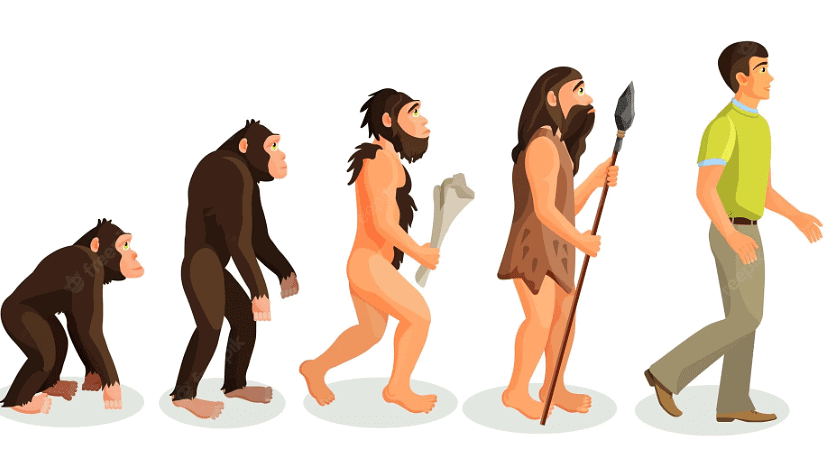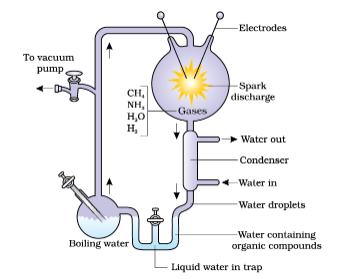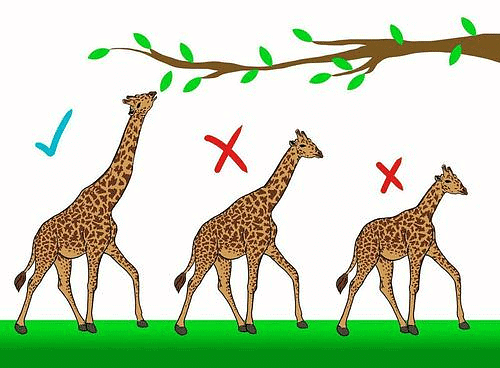Origin of Life | Biology Class 12 - NEET PDF Download
| Table of contents |

|
| What is Evolution? |

|
| Origin of Life |

|
| Did Life Come from Outer Space? |

|
| Evolution of Life Forms - A Theory |

|
Evolutionary Biology is the study of how different living things on Earth have changed over a really long time. To understand this, we need to know about how life on Earth began and how the Earth, stars, and universe have changed over time. This is a very interesting story that explains how different plants and animals came to exist on Earth. In this document, we will learn about this story and explore the history of life on our planet.

What is Evolution?
The evolution of life on earth has not been a simple process. Some explain it as a process while some interpret it as a result of various natural occurrences. The evolutionary theory tries to convey the message of the origin of the earth and how lives on earth evolved. Evolution as a process, explains how the world came into existence. It has resulted in biodiversity.
The process by which modern organisms have descended from their ancestors, with changes in their allele frequencies, is called evolution.
Origin of Life
- When we gaze at stars on a clear night, we are, in a way, looking back in time. The distances to stars are measured in light years, meaning the light we see today started its journey millions of years ago from trillions of kilometers away. In contrast, the objects around us are seen instantly, in the present moment. Thus, when we observe stars, we are peering into the past.
- The origin of life is regarded as a remarkable event in the history of the universe. The universe is vast, and in comparison, Earth is just a tiny speck. The universe is also very old, nearly 20 billion years. It is made up of huge clusters of galaxies, which in turn contain stars, gas, and dust.
- The Big Bang theory explains the origin of the universe as a massive, unimaginable explosion. This explosion led to the expansion of the universe and a decrease in temperature, resulting in the formation of hydrogen and helium. Over time, these gases condensed under gravity to form the galaxies we see today.
- About 4.5 billion years ago, Earth was formed in the solar system of the Milky Way galaxy. In its early days, Earth had no atmosphere. Water vapor, methane, carbon dioxide, and ammonia were released from the molten mass covering the surface. Ultraviolet (UV) rays from the sun split water into hydrogen and oxygen, with the lighter hydrogen escaping into space. Oxygen then combined with ammonia and methane to form water, carbon dioxide, and other substances. This process eventually led to the formation of the ozone layer.
- As the Earth cooled, the water vapor condensed and fell as rain, filling depressions and forming oceans. Life is believed to have appeared about 500 million years after the formation of Earth, nearly four billion years ago.
Did Life Come from Outer Space?
Panspermia Theory
- Some scientists propose that life might have originated from outer space.
- Ancient Greek philosophers believed in the transfer of life units, called spores, between different planets, including Earth.
- The idea of 'Panspermia,' which suggests that life seeds could be spread throughout the universe, remains popular among certain astronomers.
Spontaneous Generation
- For a long time, it was believed that life could emerge from decaying and rotting matter, such as straw and mud. This concept was known as spontaneous generation.
- However, Louis Pasteur conducted careful experiments that proved life only comes from pre-existing life.
- Pasteur demonstrated that in sterilized flasks, life did not arise from killed yeast, while in another flask exposed to air, new living organisms emerged from the 'killed yeast.'
- His findings effectively dismissed the spontaneous generation theory.
The Mystery of the First Life Form
- Despite disproving spontaneous generation, Pasteur's work did not explain how the very first life form came to exist on Earth.
Life on Earth is thought to have begun with simple organic compounds, which eventually led to the first forms of life. This process is known as 'abiogenesis' or 'biogenesis.' Scientists have proposed various theories and conducted experiments to understand how life could have emerged from non-living matter.
1. Theory of Biogenesis:
- Life arises from pre-existing life. For example, microbes like bacteria can come from the spores of other bacteria.
2. Theory of Abiogenesis:
- Life can develop from non-living matter, such as organic compounds. This theory is often associated with the idea of 'spontaneous generation.'
Oparin-Haldane Hypothesis
- Proposed by Oparin and Haldane, it suggests that the first life forms could have originated from pre-existing non-living organic molecules like RNA and proteins through a process called chemical evolution.
- Chemical Evolution involves the formation of diverse organic molecules from inorganic constituents under specific conditions.
- These conditions included a high temperature, volcanic activity, and a reducing atmosphere rich in gases like CH4(methane) and NH3(ammonia).
Miller's Experiment
 Diagrammatic representation of Miller’s experiment
Diagrammatic representation of Miller’s experiment
- In 1953, scientist S.L. Miller conducted a laboratory experiment that mimicked the conditions of early Earth. He created an atmosphere similar to that of primitive Earth, using gases like CH4, H2, NH3, and water vapor, and subjected it to electrical discharges to simulate lightning.
- Miller's experiment led to the formation of amino acids, which are the building blocks of proteins. This finding supported the idea that organic molecules could form under the right conditions.
- Other similar experiments also resulted in the production of sugars, nitrogen bases, pigments, and fats, suggesting that a variety of organic compounds could be generated from inorganic precursors.
Evidence from Meteorites
- Analysis of meteorite content has shown the presence of organic compounds similar to those formed in laboratory experiments. This indicates that similar processes of organic molecule formation may be occurring elsewhere in space, supporting the idea that the building blocks of life could be widespread in the universe.
First Forms of Life
- The first non-cellular forms of life are believed to have originated around 3 billion years ago. These early life forms were likely large molecules such as RNA, proteins, or polysaccharides that could replicate themselves.
- The first cellular forms of life, probably simple single-celled organisms, did not appear until about 2 billion years ago. All life during this period is thought to have existed in a water environment.
Acceptance of the Hypothesis
- Despite the limited evidence and the unknown details of how the first self-replicating metabolic capsules of life emerged, the idea of chemical evolution leading to the first forms of life is widely accepted among scientists.
- The gradual process of life emerging from non-living molecules through evolutionary forces is considered a plausible explanation for the origin of life on Earth.
Evolution of Life Forms - A Theory
- The theory of special creation in conventional religious literature has three ideas.
- The first idea is that all living organisms were created in their current form.
- The second idea is that the diversity of life has always been the same and will remain the same.
- The third idea is that the earth is about 4000 years old.
- Charles Darwin challenged these ideas during the nineteenth century.
- Darwin observed during a sea voyage on the HMS Beagle that existing living forms share similarities with life forms that existed millions of years ago.
- He observed that many life forms that existed in the past no longer exist.
- Darwin concluded that there has been gradual evolution of life forms.
- Populations have natural variation in characteristics.
- Individuals with advantageous characteristics that help them survive better in natural conditions outbreed others with less advantageous characteristics.
- Fitness refers to reproductive fitness, and those with higher fitness leave more progeny, hence surviving more and being selected by nature.
- This process is called natural selection and is a mechanism of evolution.
 Natural Selection
Natural Selection - Alfred Wallace also came to similar conclusions as Darwin.
- Apparently new types of organisms appear over time.
- All existing life forms share similarities and common ancestors present at different periods in Earth's history.
- The geological and biological history of Earth are closely related.
- The Earth is very old, not just thousands but billions of years old.
Key Concepts in Evolution
- Special Creation: A theory that all species were created as they are today, with no change over time, and that Earth is about 4,000 years old.
- Darwin's Observations: During his voyage on the H.M.S. Beagle, Darwin noted similarities among present-day species and ancient life forms, leading him to propose the idea of evolution.
- Natural Selection: A mechanism of evolution where individuals with traits better suited for survival and reproduction in their environment are more likely to pass on their genes to the next generation.
- Extinction and Emergence: Throughout Earth's history, certain species have gone extinct while new species have emerged, contributing to the diversity of life we see today.
- Common Ancestors: All existing life forms share common ancestors that lived at different times in Earth's history, illustrating the interconnectedness of all species.
- Geological and Biological History: The history of Earth's geology closely parallels its biological history, supporting the idea of a very old Earth, estimated to be billions of years old rather than thousands.
|
65 videos|386 docs|202 tests
|
FAQs on Origin of Life - Biology Class 12 - NEET
| 1. What is the Panspermia hypothesis regarding the origin of life? |  |
| 2. How do scientists study the origins of life on Earth? |  |
| 3. What evidence supports the idea that life could exist elsewhere in the universe? |  |
| 4. What role did RNA play in the early evolution of life? |  |
| 5. How does evolution explain the diversity of life on Earth? |  |





















